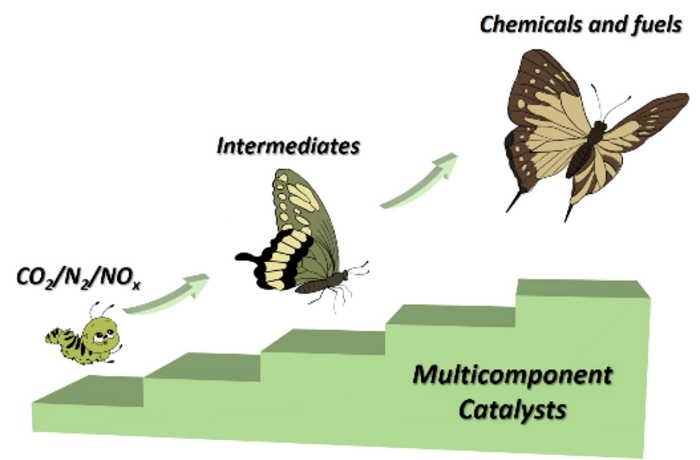Although the chemical industry has contributed significantly to the advancement of society, concerns over its effects on the environment are mounting. Through the conversion of renewable feedstocks into environmentally friendly chemicals, green chemical engineering and chemistry have created new opportunities for sustainability.

The recent progress in multicomponent catalyst design for CO2/N2/NOx electro reduction is summarized from three models. Image Credit: Buxing Han and Xiaofu Sun, Institute of Chemistry, Chinese Academy of Sciences
However, the inert bonds in molecules like CO2 and N2 make activation and conversion difficult.
Under ambient settings, electrochemical conversion offers a viable carbon-neutral pathway for enhancing green chemical sources with inert bonds to chemicals and fuels.
Compared to monocomponent catalysts, multicomponent electrocatalysts have advantages in terms of improved stability, higher activity, and broader reaction processes.
The chemical industry's sustainability issue can be addressed using multicomponent electrocatalysts. In January 2023, a group of researchers published their review of Industrial Chemistry & Materials.
The chemical industry has played a crucial role in society’s historical evolution, but it also presents emerging environmental concerns and skyrocketing CO2 emissions. We were motivated to explore the possibilities of green chemistry and chemical engineering to transform renewable feedstocks, such as CO2 and NOx, into environmentally friendly chemicals, including syngas, hydrocarbons, oxygenates, and ammonia.
Buxing Han, Study Corresponding Author and Professor, Institute of Chemistry, Chinese Academy of Sciences
Study co-corresponding author Prof. Xiaofu Sun from the Institute of Chemistry, Chinese Academy of Sciences added, “However, these inert bonds, such as the C=O bond in CO2, pose challenges to their activation and conversion. We wanted to explore electrochemical conversion as a universal carbon-neutral route to efficiently upgrade green chemical sources with inert bonds to chemicals and fuels under ambient conditions harnessing clean energy.”
He further stated, “Multicomponent electrocatalysts offer advantages over monocomponent catalysts in terms of stability, activity, and reaction processes. So, we explored the use of multicomponent catalysts in the electroreduction of small molecules such as CO2, N2, and NOx. We developed three models for multicomponent catalysts: Type I, Type II, and Type III, which we discuss in our paper.”
Type I involves a non-catalytic active component that has the ability to activate or safeguard a catalytic component. All of the catalysts in Type II provide active intermediates for electrochemical conversion. Type III involves one component providing the substrate for the other through conversion or adsorption.
Han added, “Each of these models has its own advantages and disadvantages, depending on the specific reaction and catalyst. We explored the use of these models in our paper to show their effectiveness in the electroreduction of small molecules. And we also discussed future directions for applying multicomponent electrocatalysts in the industrial utilization of renewable chemical sources through highly efficient activation and conversion of inert bonds.”
The Main Issues That Need To Be Resolved To Create and Use Multicomponent Electrocatalysts To Activate and Transform Renewable Chemical Sources
“One key challenge is improving the selectivity and efficiency of the electrocatalysts, as well as increasing their stability and activity. "Another challenge is understanding the fundamental mechanisms of the electroreduction reactions and how they are influenced by the multicomponent catalysts,” Han stated.
He concluded, “More importantly, there is a need for further research and development to scale up and integrate these electrochemical processes into industrial applications. Many promising research projects are undergoing in our lab.”
Journal Reference:
Jia, S., et al. (2023) Multicomponent catalyst design for CO2/N2/NOx electroreduction. Materials Chemistry Frontiers. doi:10.1039/D2IM00056C.